I recently came across a term that I had never heard before.
Plant Blindness.
The term was coined in 1999 by botanists James Wandersee and Elisabeth Schussler. They described it as “the inability to see or notice the plants in one’s own environment”. William (2003) puts a little more into it “Plant blindness is a form of cognitive bias, which in its broadest meaning, is a human tendency to ignore plant species. This includes such phenomena as not noticing plants in the surrounding environment, not recognising the importance of plant life to the whole biosphere and to human affairs, a philosophical view of plants as an inferior form of life to animals and/or the inability to appreciate the unique features or aesthetics of plants”. Wandersee and Schussler cite evidence showing that humans don’t see all their surroundings by just opening their eyes. Researchers have calculated that each second the eyes generate more than 10 million bits of data for visual processing but the brain extracts only about 40 bits and fully processes only the 16 bits that reach our conscious attention. As a survival mechanism the brain searches for movement, conspicuous colours and patterns, objects that are known, and objects that are potential threats. Since plants are static, blend in with the background, and don’t eat humans, they generally don’t get visual attention.

This is all well and good from a reductive scientific point of view because although plants may not evoke a fight or flight response they do inhabit our days. From the food we eat (1), to the weeds that invade our nice clean lawns/parks/waterways, to the trees that block our views or gutters and to the Council tended urban landscapes and green spaces we can add any garden, ornamental or otherwise, and house/office plants that inhabit the spaces we do. We are surrounded by plants, we notice the changes in them as the seasons progress while we make our daily work commute. We may not consciously see them but we feel them, their presence.
- leaf, herb, stalk, flower, bud, fruit , root, bulb, corm, rhizome, tuber, bark, seed, grain,
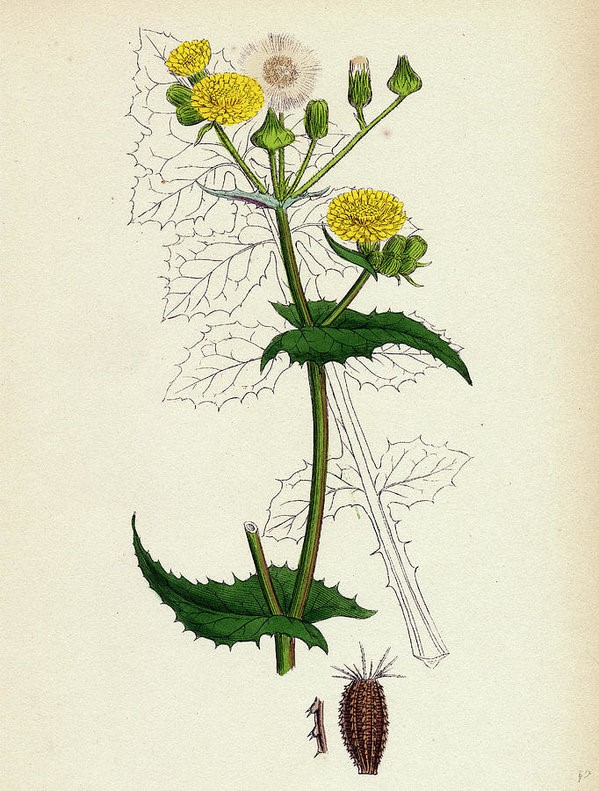
To me plant blindness is something a little different. Plant blindness is the inability to recognise the differences between plants via visual or other cues. The person may be unable to tell the difference between culinary herbs such as sage or parsley by sight or basil and sage by scent. Even people familiar with herbs may have difficult telling young plants apart. Coriander, flat leaved parsley and even dill can look quite similar. They would certainly be unable to go into a garden and pick a specific herb from a description or even describe a particular plant. Often the only descriptive term available to them is “green”. Take into account that these are everyday plants, found in every supermarket/farmers market/Italian Grandmothers garden. When we get to wildcrafting we are talking about plants less commonly seen. We have to get out of our cars and walk the peripheries of parks, the banks of creeks/stream/rivers/lakes/ponds, the semi wild places, the places where the edges meet. (Oh for an English hedgerow) You need to slow down. You need to look. But most of all you need to be able to see. This can easily be learned.
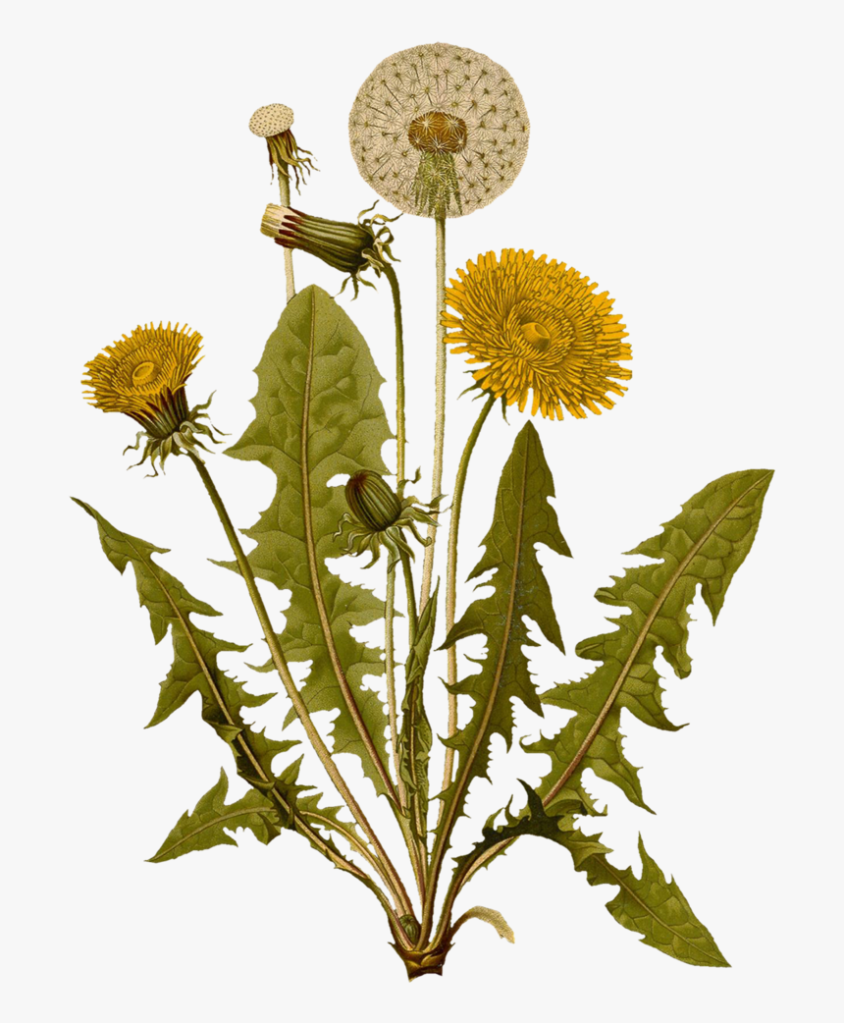
Plant blindness can potentially be deadly. Many edible/medicinal herbs and berries have toxic look-alikes. One of my first plant memories is that of my mother teaching me about the poisonous nature of lantana and nightshade berries and how to identify the wildly poisonous oleander plant. I was 4 or 5 years old at the time. I grew up in the country and up to the age of 10 I was raised largely amongst aboriginal peoples. Part of this upbringing involved a fairly deep exposure to nature that instilled in me a knowledge of plants that (up until we moved to the city and I went to high school) I thought was common knowledge. I hadn’t really thought about it that way until now (now that I think about it) but perhaps it was their complete lack of awareness that made me aware of my own level of awareness (If you get me). From weed to tree it surprised me how little that city folk knew about plants in general.
As a perfect example of plant blindness I have chosen the herb dandelion. Dandelion (Taraxacum officinale) is a common plant and can be found worldwide (except maybe Antarctica and the Northern Arctic Circle. It is a readily accessible and common urban weed that is regularly misidentified. There are no poisonous plants (1) that can be readily misidentified as dandelion (2) but I find that (3) dandelion is easily confused with a number of different plants. What is all the more confusing is that all of these plants are also common urban weeds and they share many of the same spaces that dandelion inhabits. All of the plants discussed in this guide are edible (4) and have medicinal usage (5).
- that I am aware of – correct me if you know of any
- although one author I read noted that catsear is a poisonous dandelion look-alike. I consider this to be erroneous
- even amongst naturopaths I know
- at some stage of their lifecycle – particularly when young
- to one degree or another. The only plant however that is utilised with any degree of regularity is dandelion.
CAUTION : This goes for all wildcrafting in general “If you are not 100% sure of the identity of a plant then DO NOT ingest it. Do not use it for food or medicine. 100% sure is the equivalent of knowing the difference between milk and orange juice when you go to the fridge. If you do not know the plant with this level of certainty then do not use it.
“All mushrooms are edible. Some of them only once.”(1)
- more or less. Various “ethnic” sayings quote similar aphorisms….and Terry Pratchett, author of Discworld, quotes something similar
Taraxacum officinale
also known as dandelion (late Middle English: from French dent-de-lion, translation of medieval Latin dens leonis ‘lion’s tooth’ (because of the jagged shape of the leaves), pissenlit, piss-a-bed (so named because of its diuretic properties)
Dandelion is a valuable and regularly utilised medicinal plant. Dandelion root is traditionally used as a gentle digestive bitter to improve digestion, increase bile flow, relieve nausea and vomiting and improve appetite. Dandelion leaf is prescribed in cases of cystitis, appetite loss, dyspepsia, flatulence, bloating and urinary complaints.
All parts of plant (leaf, root, flower) are edible. The plant becomes more bitter as it ages and after flowering
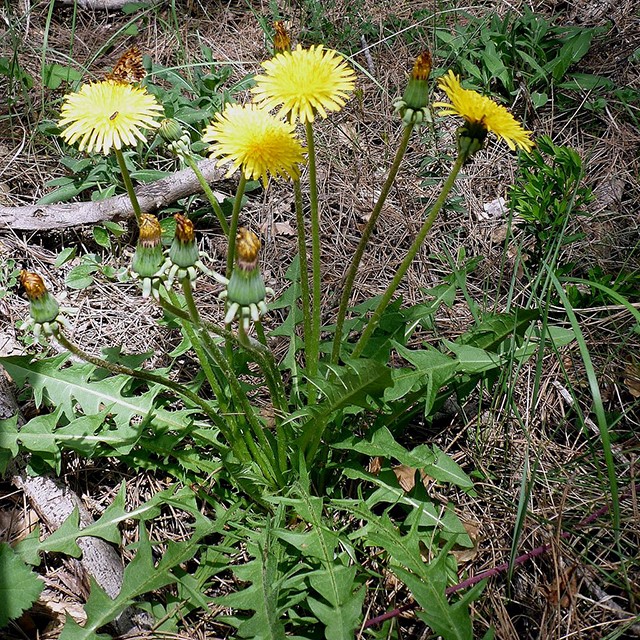
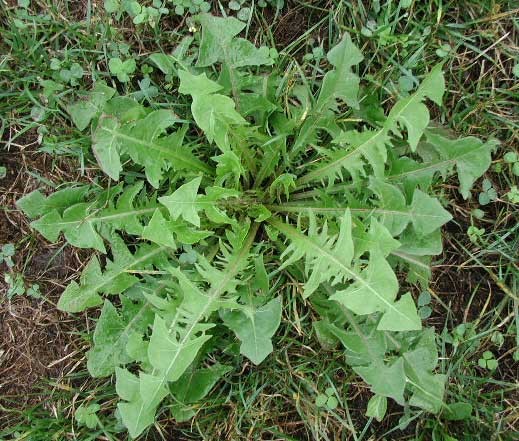
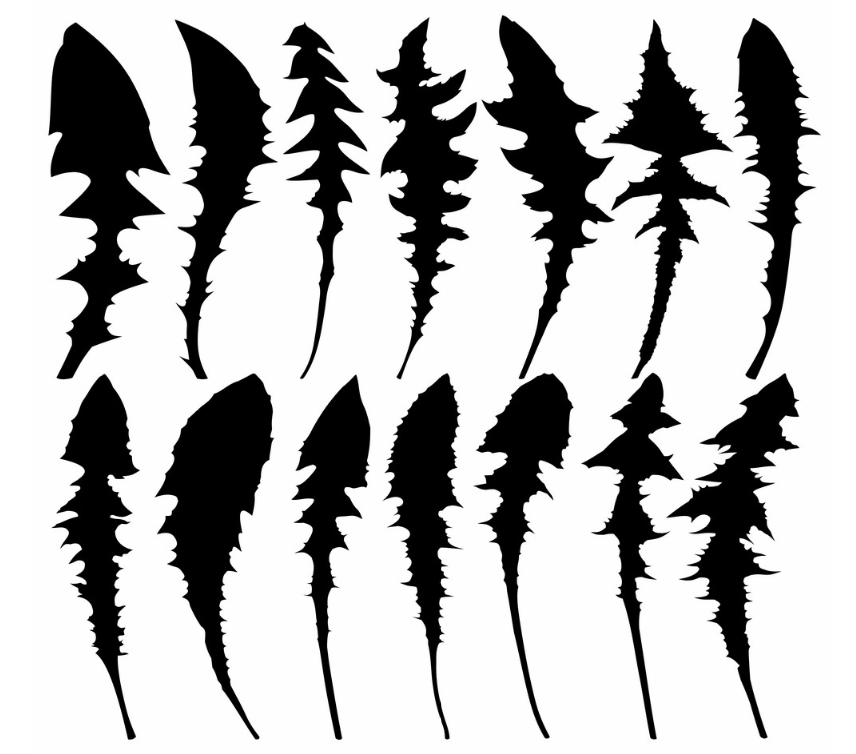
Variations in dandelion leaf shape. Dandelions have smooth leaves with jagged margins

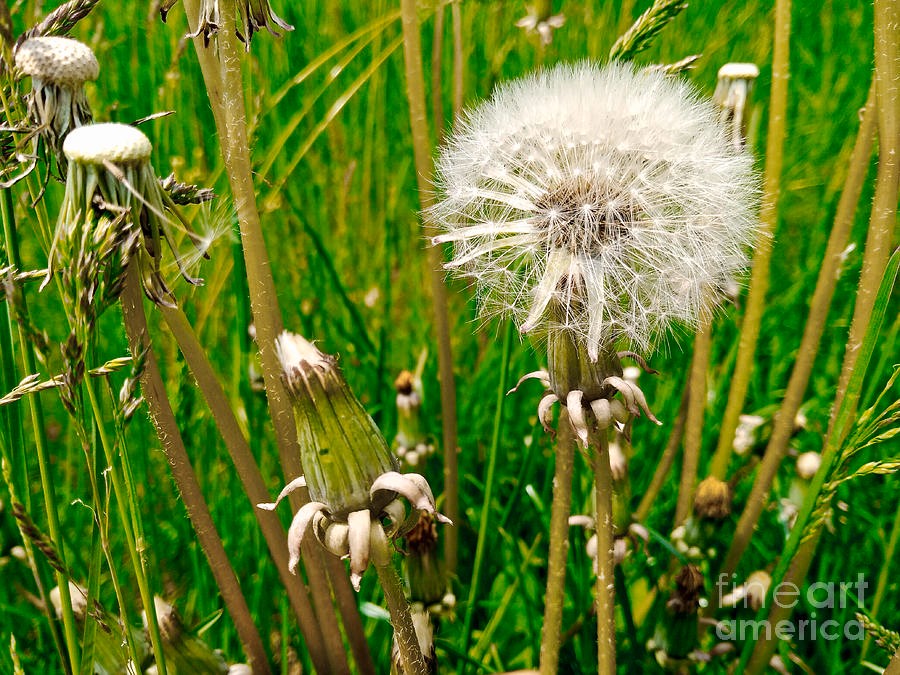
Dandelion seed head showing soft white fibres (pappus) that helps windborne transmission of seed 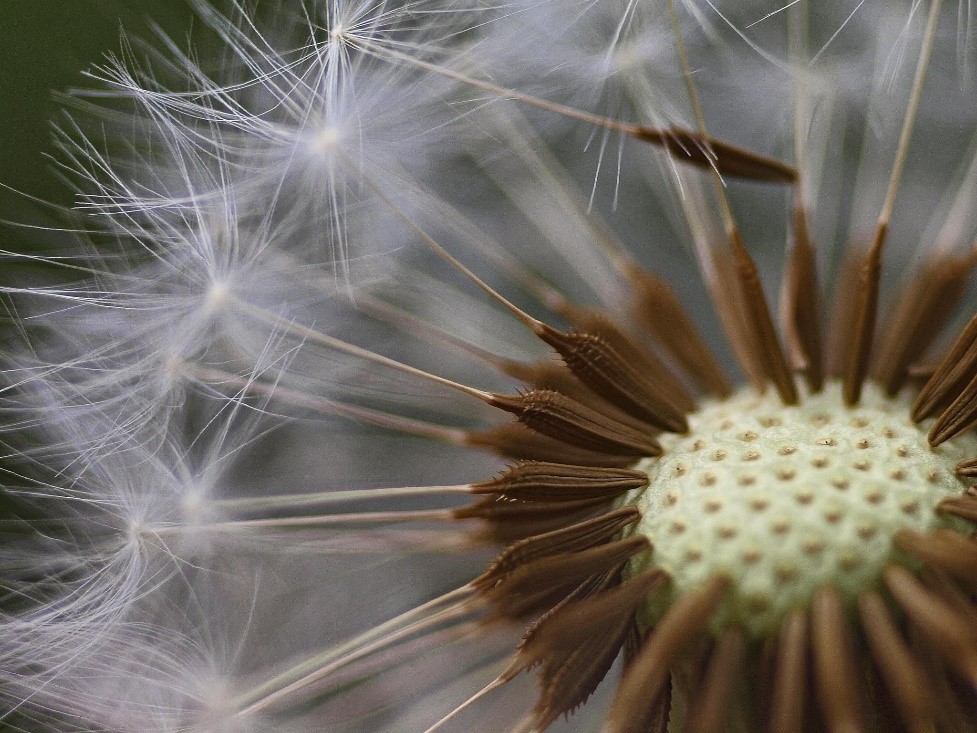
Close up of dandelion seed head
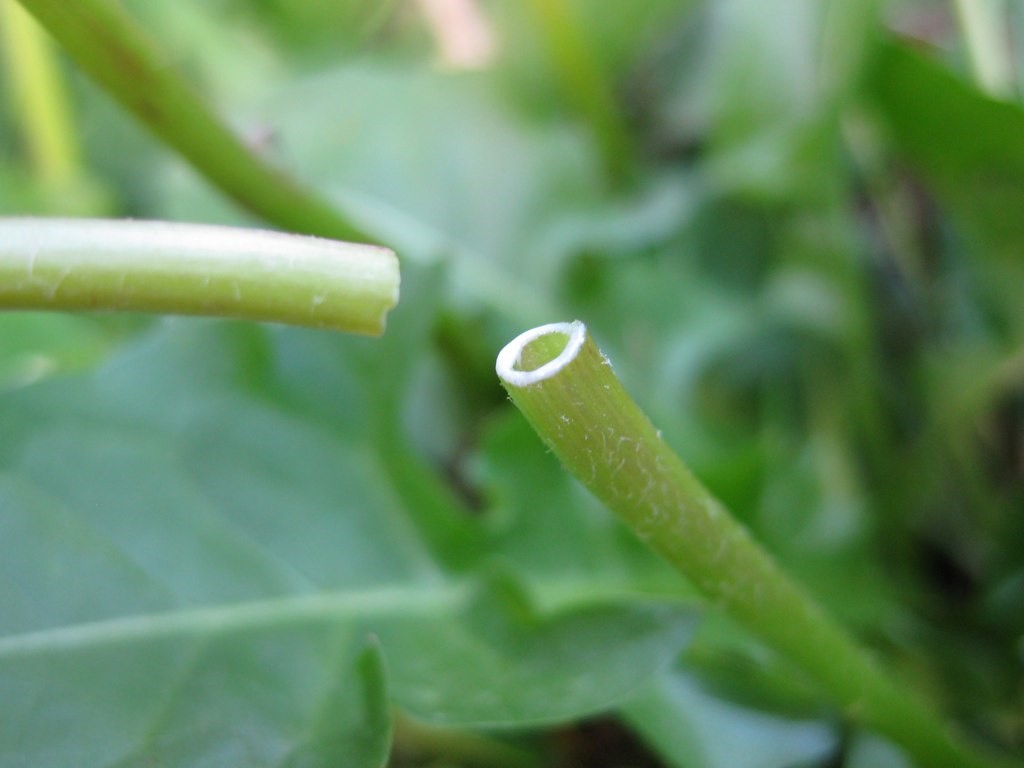
Hypochaeris radicata
(sometimes spelled Hypochoeris radicata)
also known as catsear, flatweed, cat’s-ear, hairy cat’s ear, false dandelion
All parts of this plant are edible. The leaves and roots are most commonly used. The leaves are less bitter than that of dandelion but become much tougher and more fibrous than dandelion leaves as the plant ages.
Stringhalt, a unique disease of horses characterized by spasmodic hyperflexion of one or both hind legs, has been associated with horses eating Hypochaeris radicata.
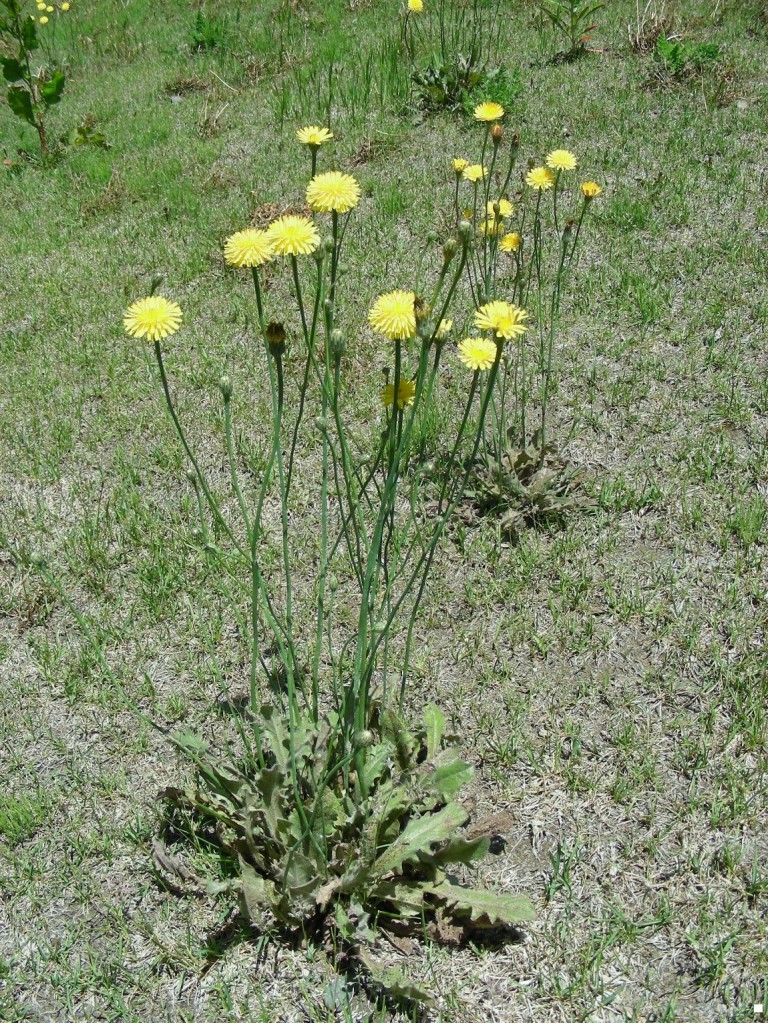
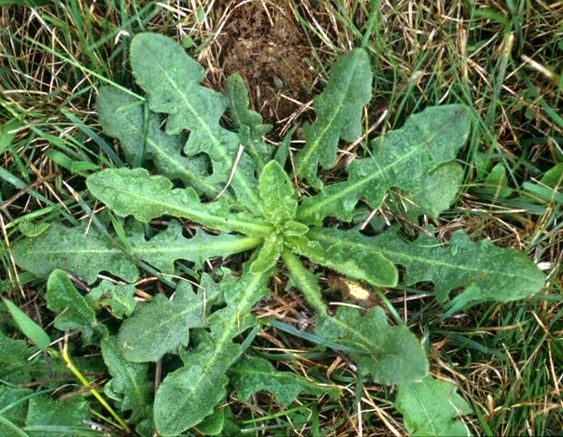
Young catsear. Plant is most edible at this stage. Leaf is most edible part of plant. Plant becomes more bitter as it ages and after flowering. Has white latex sap typical of these plants
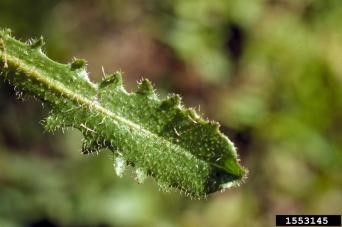
The leaf of the catsear differs from that of the dandelion (as well as sowthistle and wild lettuce) in that it has rounded, lobed margins rather than the jagged leaf margins the others possess.
The photo of the catsear leaf shows the hairs typical to this plant. Neither dandelion, sowthistle nor wild lettuce demonstrate this trait (although wild lettuce does develop “prickles” along older leaves and the stem. The leaves of the catsear seem almost succulent.
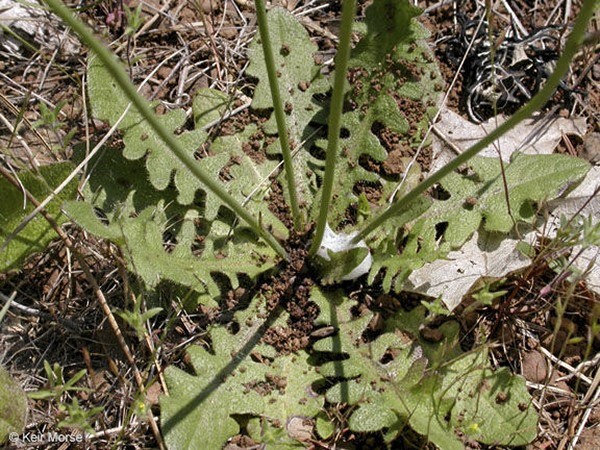
Basal rosette of leaves showing solid stems. These stems become branched and will produce multiple flowers. Dandelions will produce only one flower per stem and does not branch.
This plant produces the least quantity of edible leaves. The photo above shows a mature, just flowering plant. Its leaves are neither sizeable nor abundant. Sowthistle provides the largest supply of leafy green material with dandelion coming in second. Catsear and wild lettuce would only be really used as a survival food (when very young, green and tender).
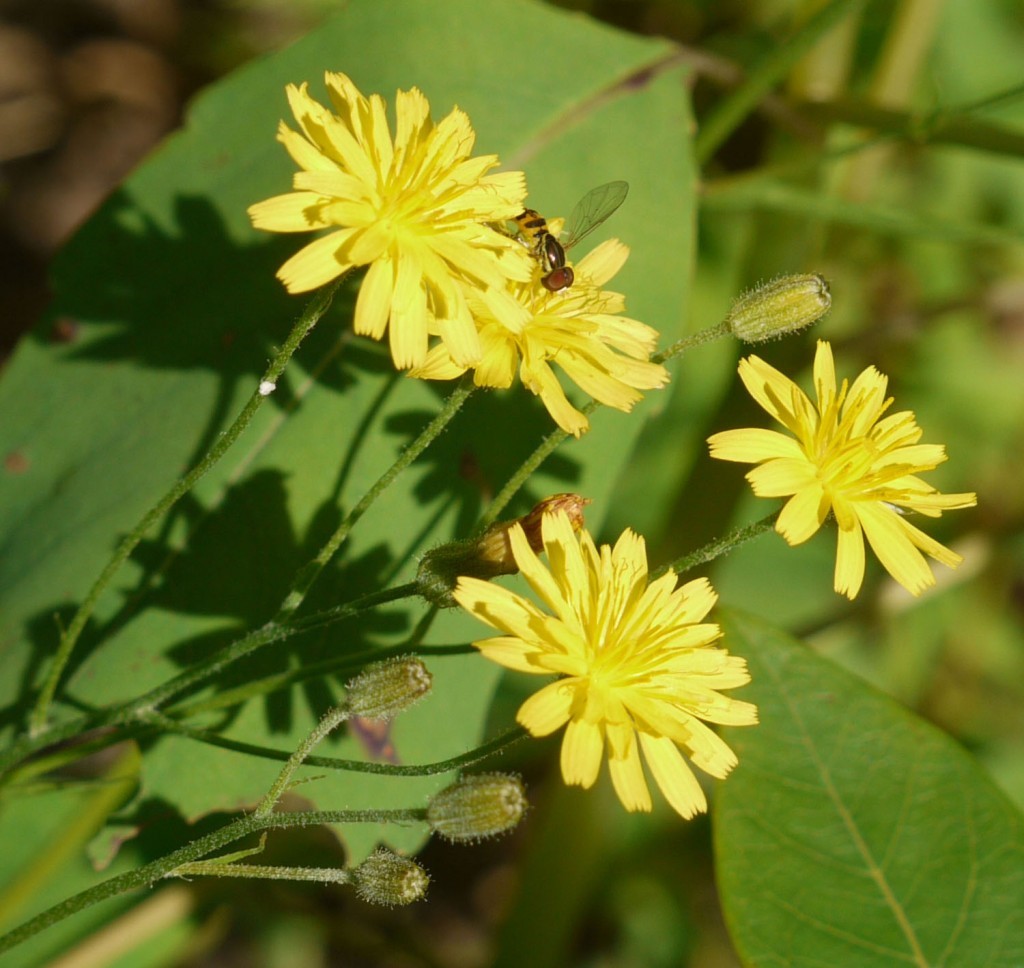
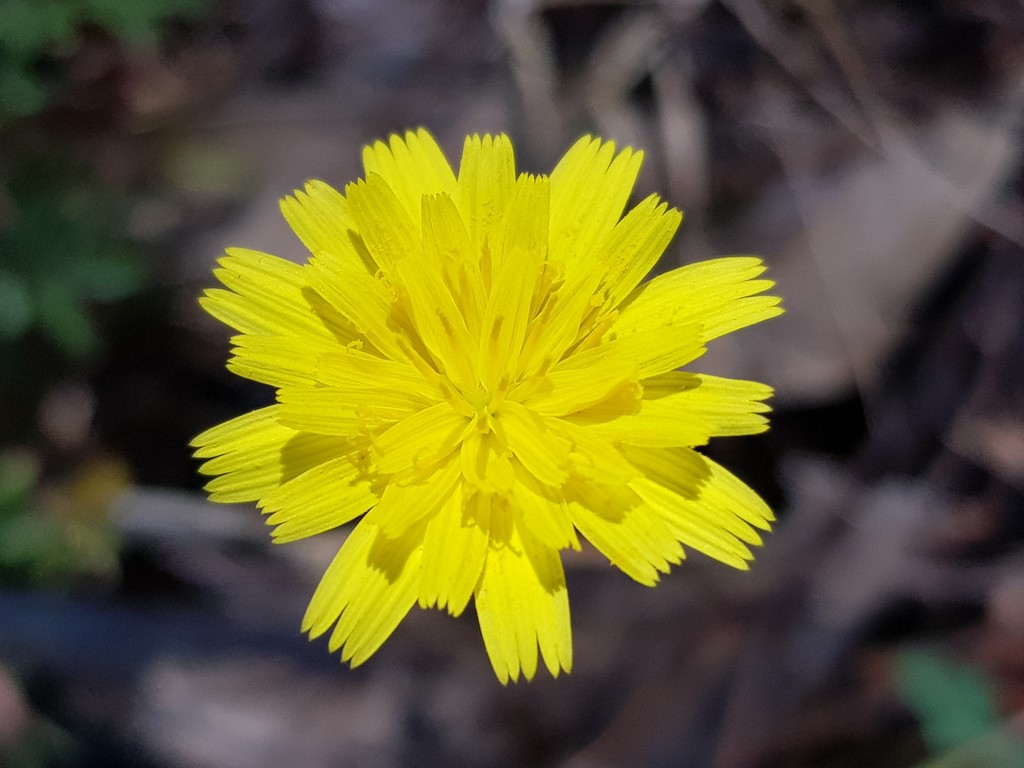
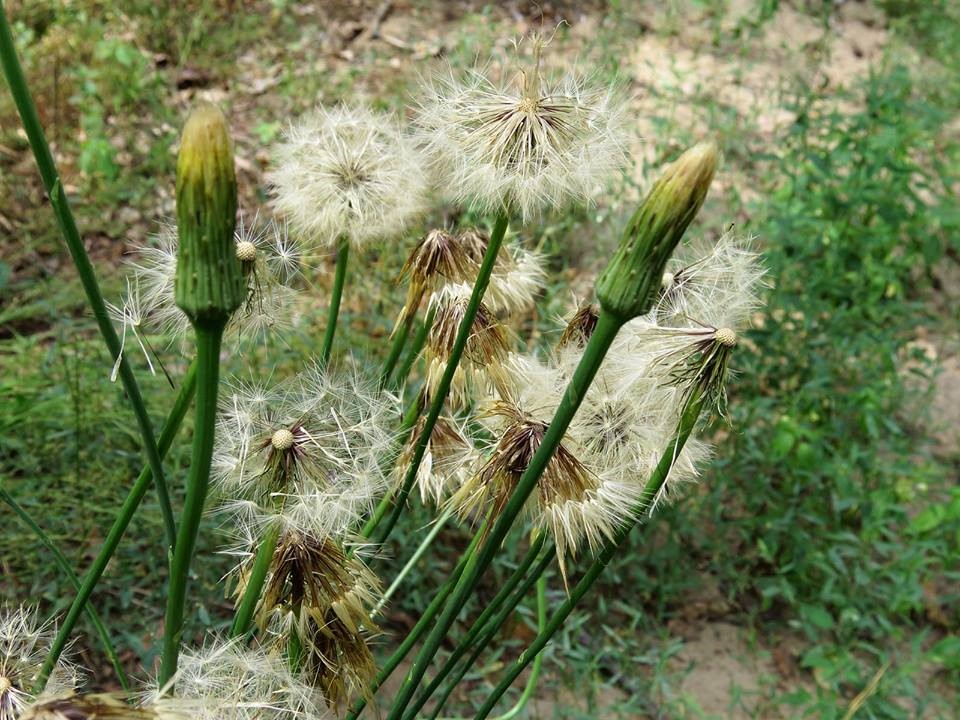
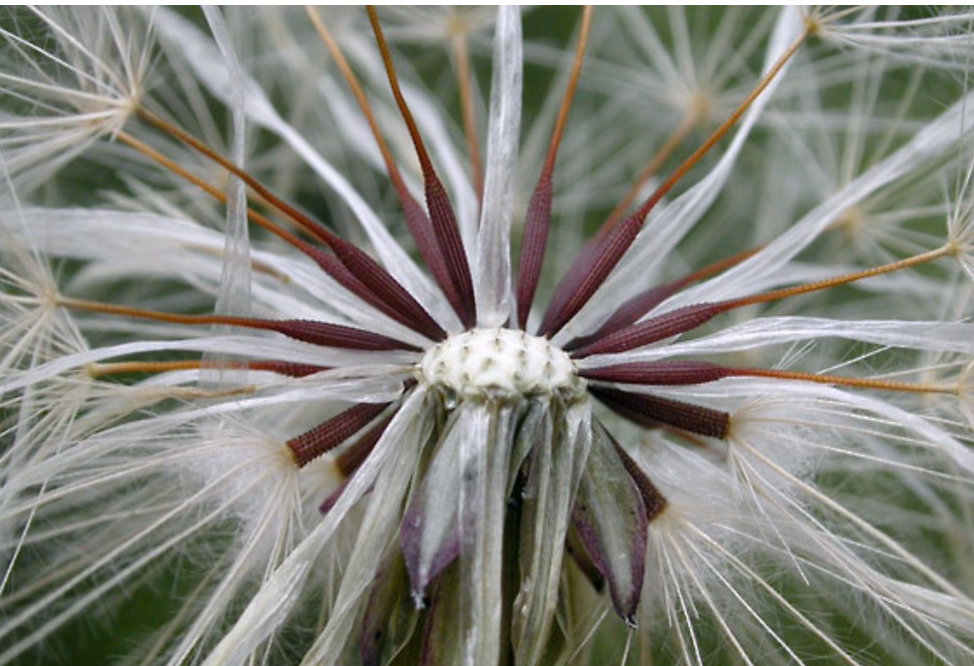
Sonchus oleraceus
also called common sow thistle, smooth sow thistle, annual sow thistle and (less commonly) hare thistles or hare lettuces, puwha, puha, pororua or rauriki, (Maori names)
The name “sowthistle” came from the observation (and supposition) of a 17th Century herbalist, Dr William Coles, that when sows had piglets they “greedily desired” this plant because they knew by “certain natural instinct” that it would increase their milk production.
The plant is eaten mainly for its highly nutritious leafy greens although the young roots and flowerbuds are said to be edible. Sowthistle was one of the plants used by the British explorer Captain James Cook (1728 – 1779) as an antiscorbutic to prevent his sailors dying from scurvy.
This plant has some medicinal use. This herb is used primarily as a digestive tonic and blood purifier. Traditionally an infusion of this herb has been used to bring on late or suppressed menstruation, as a galactagogue to increase milk production in breastfeeding mothers, to improve loose bowels, eliminate worms, as a liver tonic and to strengthen digestion. The sap was diluted in water and drunk to cool the stomach, ease inflammation, eliminate kidney stones and to relieve diarrhoea.

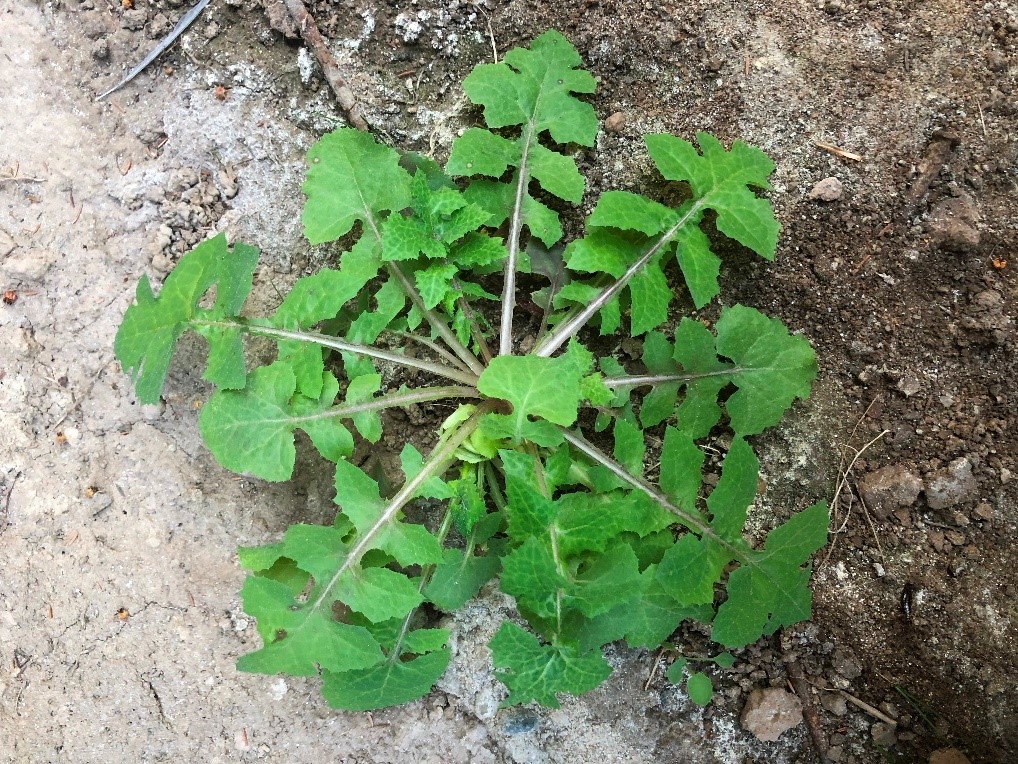
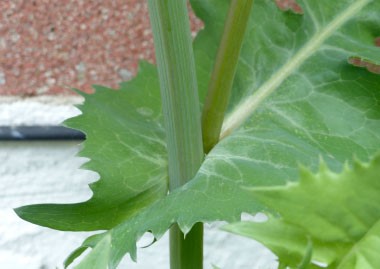
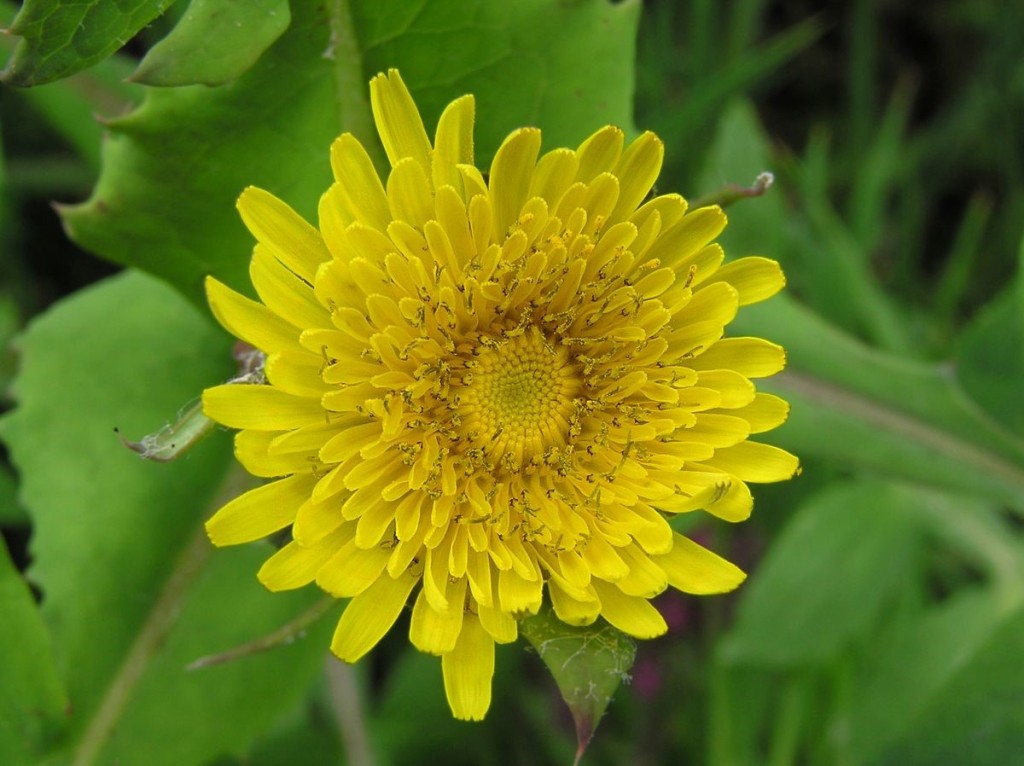
Sowthistle flowerhead
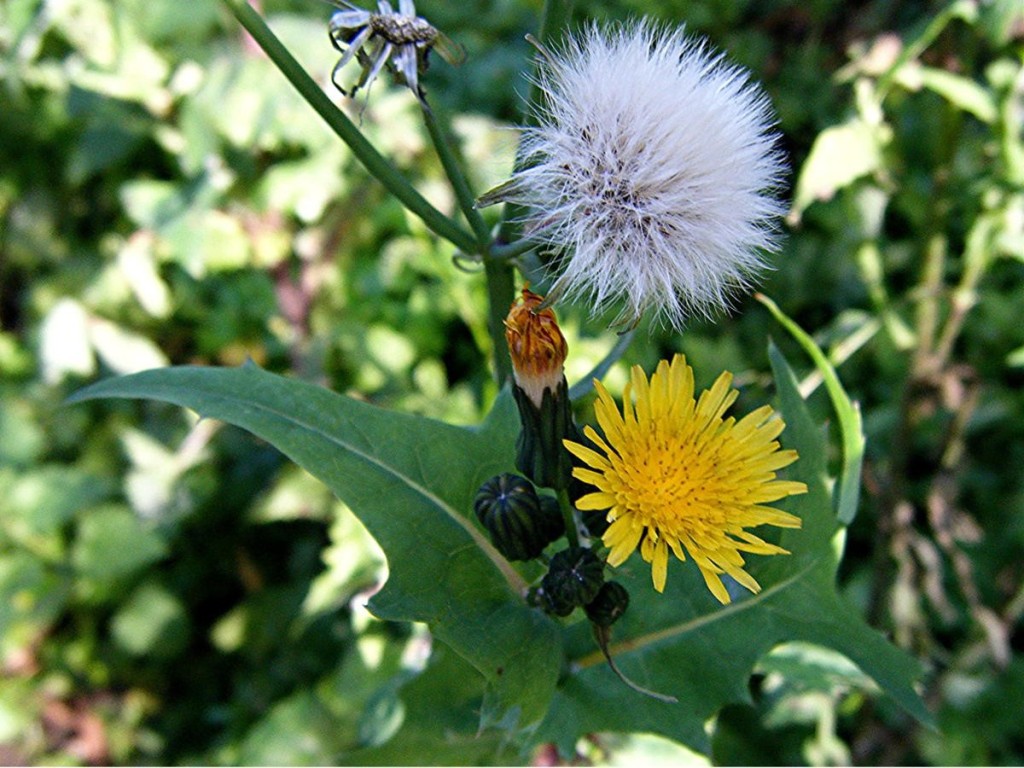
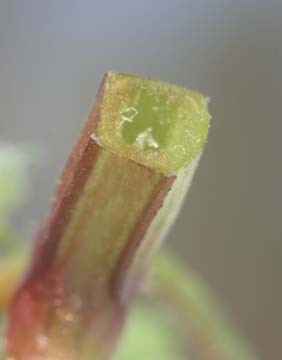
Close up of sowthistle stem showing its hollow and angular nature 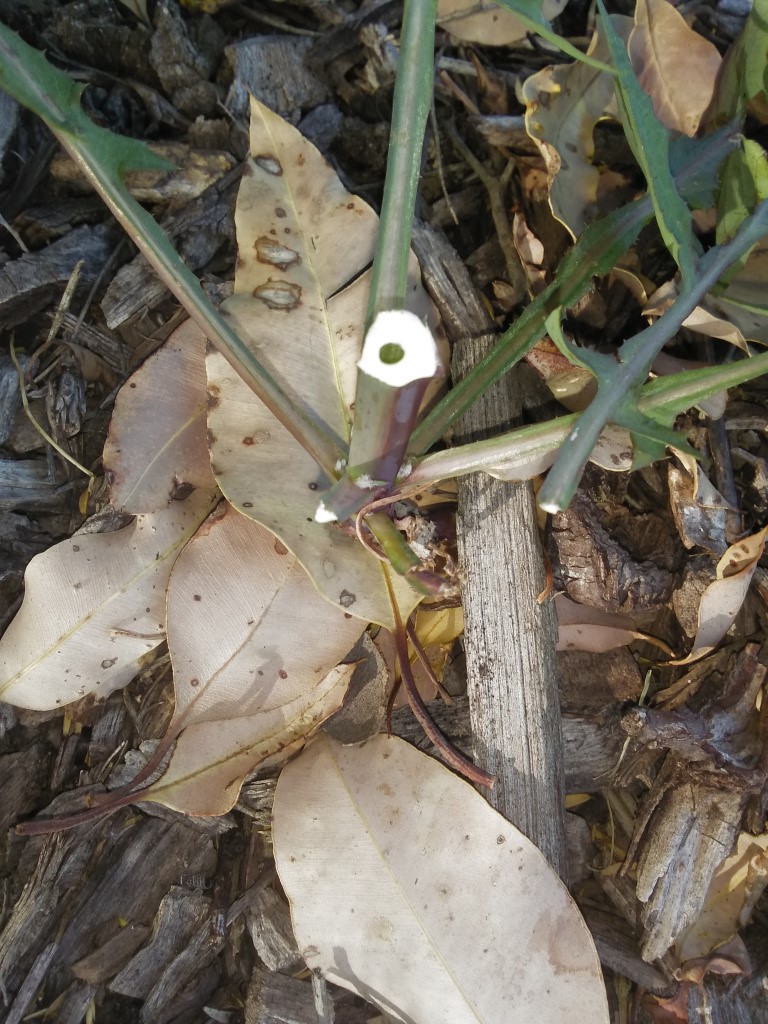
Cut sowthistle stem showing latex
Lactuca virosa
Lactuca “milky extract” virosa “toxic”
“Laitue vireuse” in French : “Wilder lattich” in German : “Allubbyne” in Arabic
also called wild lettuce, wild opium
This plant is related to domestic lettuce (Lactuca sativa)(1). This plant however is only edible for a short period of time while it is young and the leaves are still tender. This plant has a history of medicinal use.
- probably much in the same way that corn is related to teosinte.
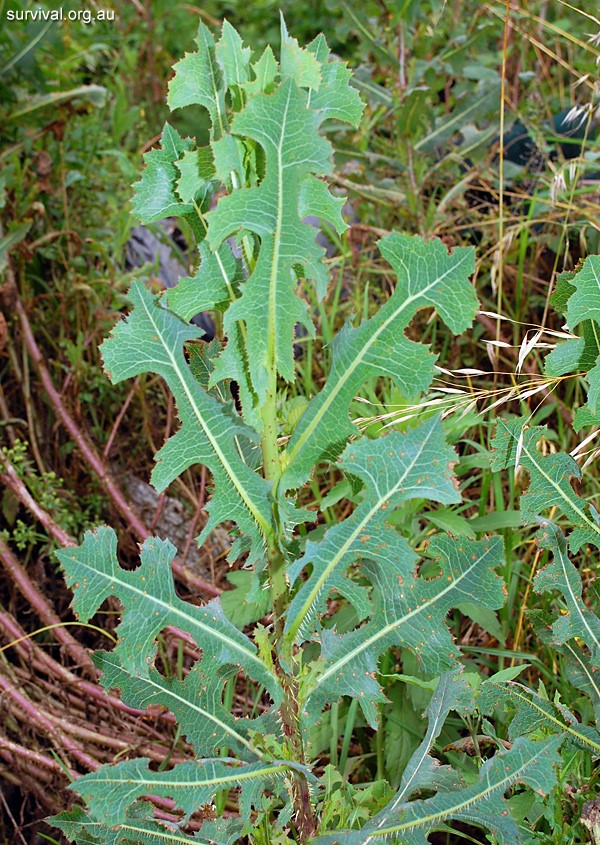

Young wild lettuce plant. Plant is most edible at this stage. Leaves may be smooth or hairy and have jagged margins. The shape of this leaf is the one most similar to dandelion. Leaves rapidly stiffen as the plant matures 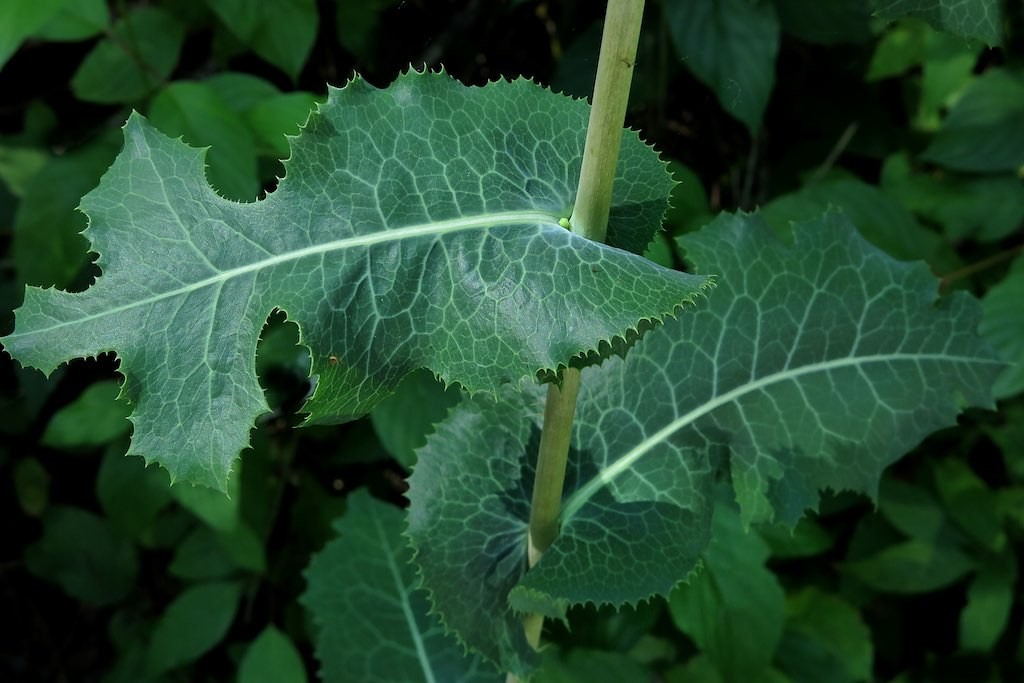
Leaf clasping stem (similar to sowthistle)
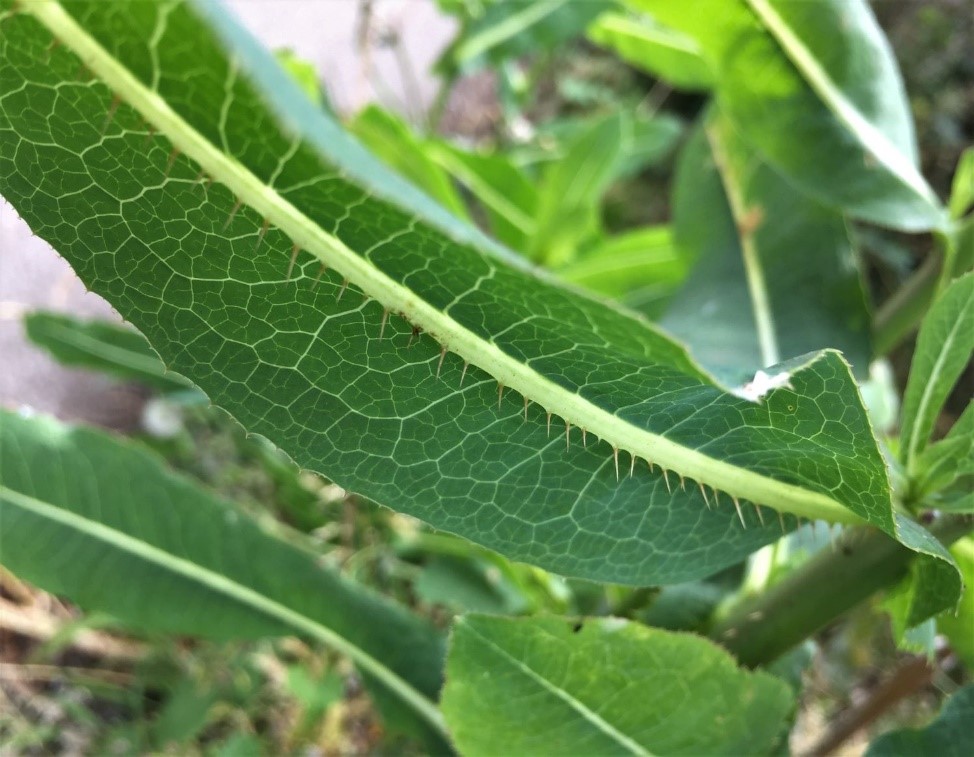

Mature flowerhead showing multiple blossoms per peduncle 
Wild lettuce flower
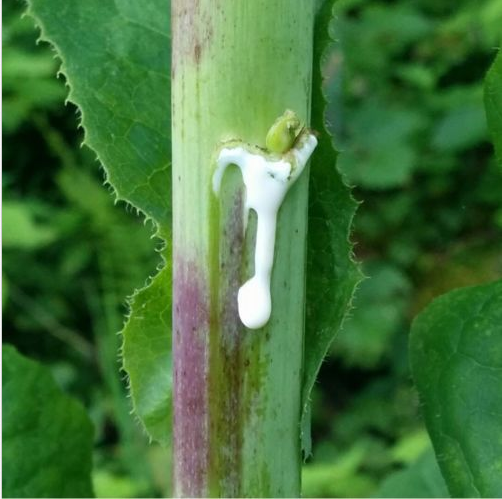
The white sap of this plant can be harvested and dried into a brown substance known as lactucarium. Concentrations of lactucarium are low in young plants and most concentrated when the plant comes into flower. If procured later in the season the latex “may be thicker but it contains less of the bitter matter on which its virtues probably depend” (Anilakumar etal 2017). From its variable strength, lactucarium may be employed for calming nervous disquietude, relieving pain, and producing sleep, in cases in which, in consequence of the existence of some contraindication, opium cannot be used. Thus, having little or no stimulant influence over the circulation, it may be used in inflammatory and febrile conditions in which the excitant action of opium might prove injurious. Not having, at least in an equal degree, the property of checking the secretions, it is better adapted to the early stages of catarrhal disease; and, perhaps, it’s most advantageous application is to the alleviation of cough. It is said, moreover, to be less than opium to cause headache, nausea or other disorder of digestion, and constipation; and may agree well with constitutions, which from idiosyncrasy may not be kindly affected by that narcotic. It has been specially recommended to allay cough in phthisis (1), catarrh (2), and other pulmonary complaints; to compose nervous irritation and produce sleep in febrile diseases of all kinds, idiopathic (3), exanthematous (4), and symptomatic; to quiet palpitation of the heart; and to relieve pain in chronic rheumatism, colic, gastralgia (5), and excessive sensibility of the eyes. (Anilakumar etal 2017). Lactucarium is a diuretic, laxative, spasmolytic and sedative agent which relieves dyspnoea (6), and decreases gastrointestinal inflammation and uterus contractions. It has anticonvulsant and hypnotic effects and in the 19th Century was well known as a painkiller and sedative. In 1917, the Servall Company asserted that wild lettuce was “highly esteemed to quiet coughing and allay nervous irritation, a good safe remedy to produce sleep, to be used when opium and other narcotics are objectionable” (Besharat 2009). Medicines which contain lactucarium are used in the treatment of pertussis (7), bronchial asthma and urinary tract diseases.
- A Greek word meaning “a dwindling or wasting away.” Pronounced TIE-sis. Phthisis is an archaic name for tuberculosis.
- excessive discharge or build-up of mucus
- relating to or denoting any disease or condition which arises spontaneously or for which the cause is unknown.
- an eruptive disease, especially one attended with fever, as smallpox or measles.
- pain in the stomach or epigastrium (the part of the upper abdomen immediately over the stomach) especially of a neuralgic (relating to the nerves) type.
- difficult or laboured breathing.
- whooping cough
Dose of lactucarium in pill or powder, which is the most efficient mode of administration, from 5 grains (1) to 20 grains (2); of the tincture, 30 drops to 60 drops; of the alcoholic extract, 1 grains to 5 grains. Some of its side effects and toxicity resulting from overdose include mydriasis (3) and photophobia (4), dizziness, diaphoresis (5), auditory hallucination (6), and cardiovascular and respiratory difficulties caused by dysrhythmia (7) (Zargari 1990).
- A grain is a unit of measurement of mass, and in the troy weight, avoirdupois, and Apothecaries’ system, equal to exactly 64.79891 milligrams.
- 20 grains = 1 scruple (℈); 3 scruples = 1 dram (dr); 8 drams = 1 ounce); 12 ounces = 1 pound. The grain, ounce, and pound are the same as in troy weight, the grain alone being the same as in avoirdupois weight.
- dilation (widening) of the pupil of the eye.
- extreme sensitivity to light.
- sweating, especially to an unusual degree as a symptom of disease or a side effect of a drug.
- Auditory hallucinations are false perceptions of sound. They have been described as the experience of internal words or noises that have no real origin in the outside world and are perceived to be separate from the person’s mental processes
- abnormality in a physiological rhythm, especially in the activity of the brain or heart.
It is listed in the United States Pharmacopoeia and instructions for its manufacture. “It is obtained by cutting off the upper portion of the stem, thus allowing the latex to exude, so that it can be transferred to a small cup. After twenty-four hours a thin slice is removed from the cut surface and the operation repeated. The collected latex soon solidifies, and is then removed from the cup, cut into pieces, and dried, gradually acquiring a dull brownish colour during the process. The drug occurs in hard, opaque, irregular pieces, often curved on one side. They are dull brown in colour, but the interior, in recent pieces, may still be whitish and soft. The odour is characteristic, recalling that of opium; taste, bitter.” The dried latex may be dissolved in alcohol or smoked as pure resin or in a smoking blend together with herbs such as Cannabis or thorn apple (Miller 1985). A modern method used to take wild lettuce is to dry the leaves and roots and smoke them. Yet another technique is to heat, not boil, the leaves in water for at least eight hours and then remove the liquid. The lactucarine leaches into the water solution. Once the water has evaporated, the result is a black gum that is often smoked. This resin must be sealed in plastic to prevent it from drying out. An effective dose is generally about one ounce of dried wild lettuce leaves or approximately one-half gram of the extract per person.
Lactuca was still listed in the British Herbal Pharmacopoeia as late as 1983 (that’s how old my copy is anyway) as a herbal medicine. It is listed as being a mild sedative, anodyne (1), and hypnotic. It is recommended for the treatment of insomnia, restlessness and excitability in children, pertussis, irritable cough, priapism (2), dysmenorrhea (3), nymphomania (4) and muscular or articular (joint) pains. It is recommended that the powdered, dried leaves be used. You take 0.5 – 3g 3xday. The powder can be encapsulated or infused as a tea. The 1:1 (5) tincture of 25% alcohol is taken at 0.5 – 3ml also 3xday
- pain killing, another version of the word analgesic.
- Priapism is an unwanted, persistent erection (usually without sexual arousal). It may occur spontaneously or from certain antidepressants or erectile dysfunction drugs. Symptoms include an erection lasting more than four hours or off and on for several hours. The penis is usually painful or tender. Prompt treatment is required. Options include draining blood from the penis (aspiration) and medication to restrict blood flow to the penis.
- painful menstrual cycle
- uncontrollable or excessive sexual desire in a woman (in men it’s called satyriasis). Essentially it’s a form of hypersexuality.
- each ml contains 1g (or 1000mg) of herb. A 1:2 indicates that each 2ml of liquid contains 1000mg of herb (so only 1/2 the strength of a 1:1). A 2:1 indicates that there are 2000mg of herb in 1ml of liquid (so double the strength of a 1:1)
Comparisons
Young plant
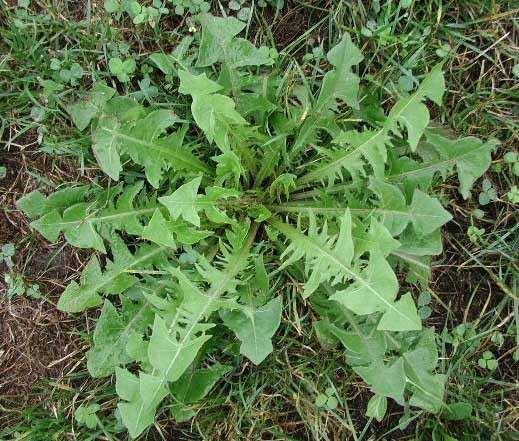
Dandelion 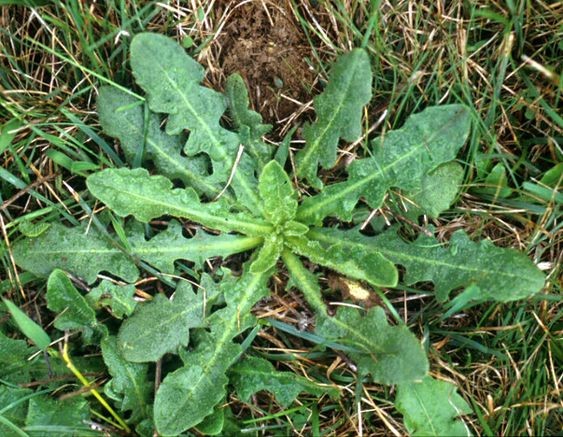
Catsear

Sowthistle 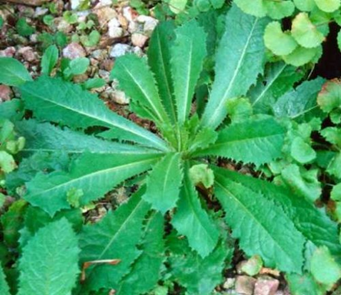
Wild Lettuce
Leaf
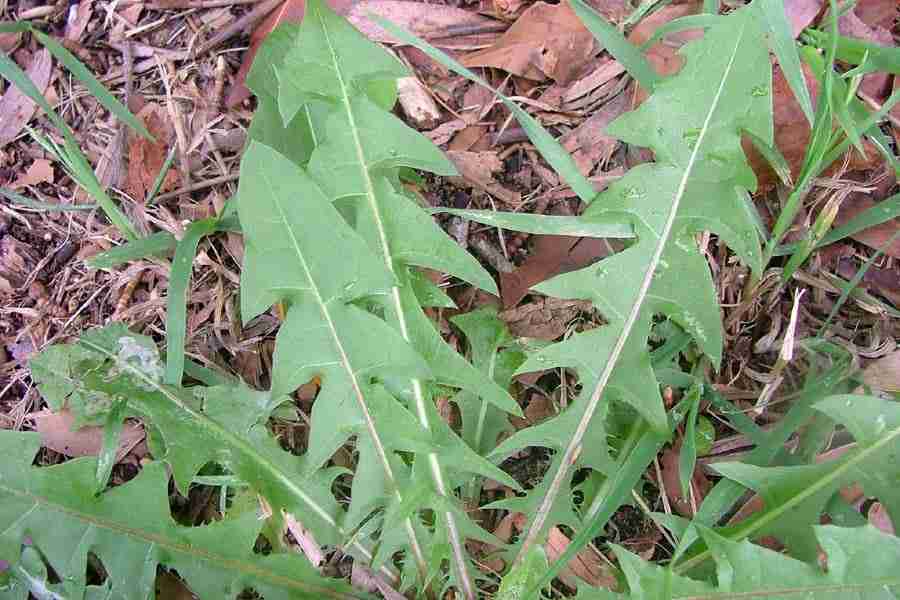
Dandelion 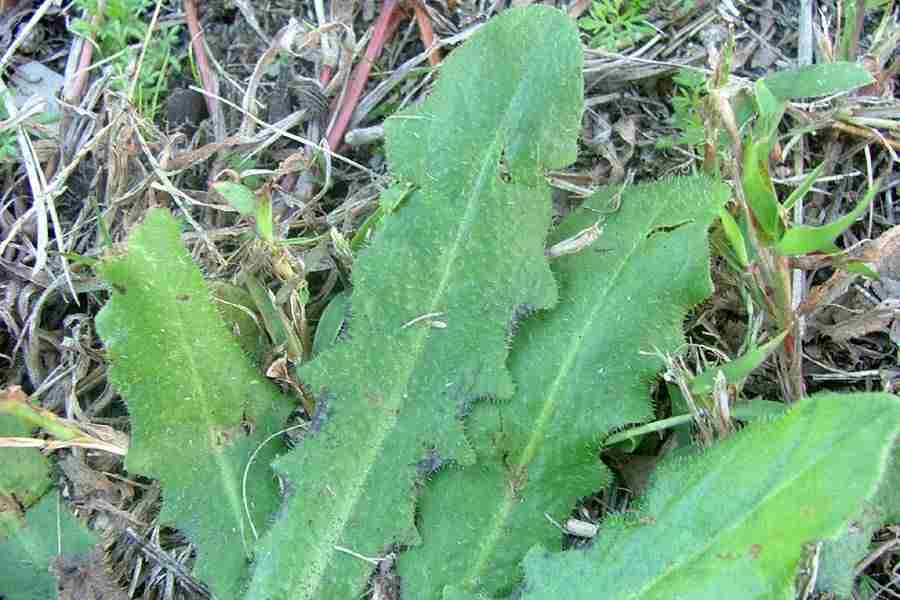
Catsear
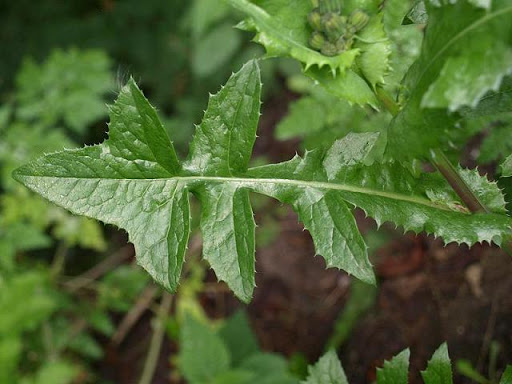
Sowthistle 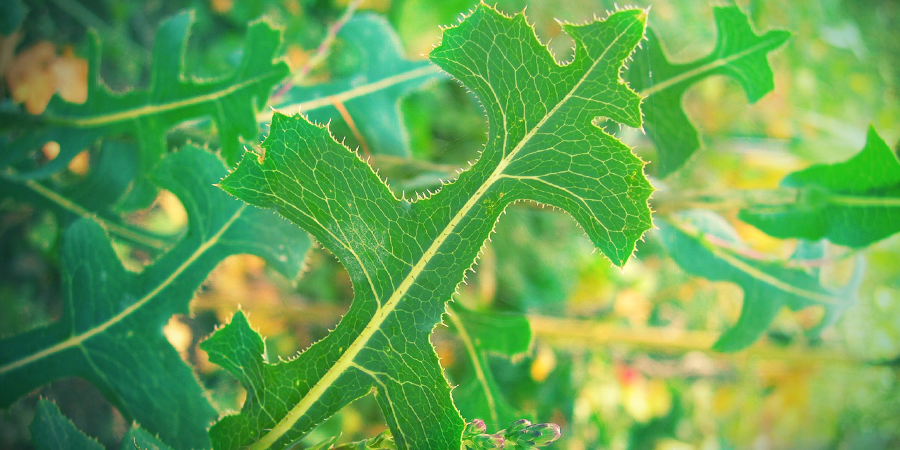
Wild Lettuce
This is just an example of leaf shape for all of these plants. There is a wide variation across all of these plants. The only plant that has (more or less) a uniform leaf shape is that of Catsear.
Flower Head

Dandelion 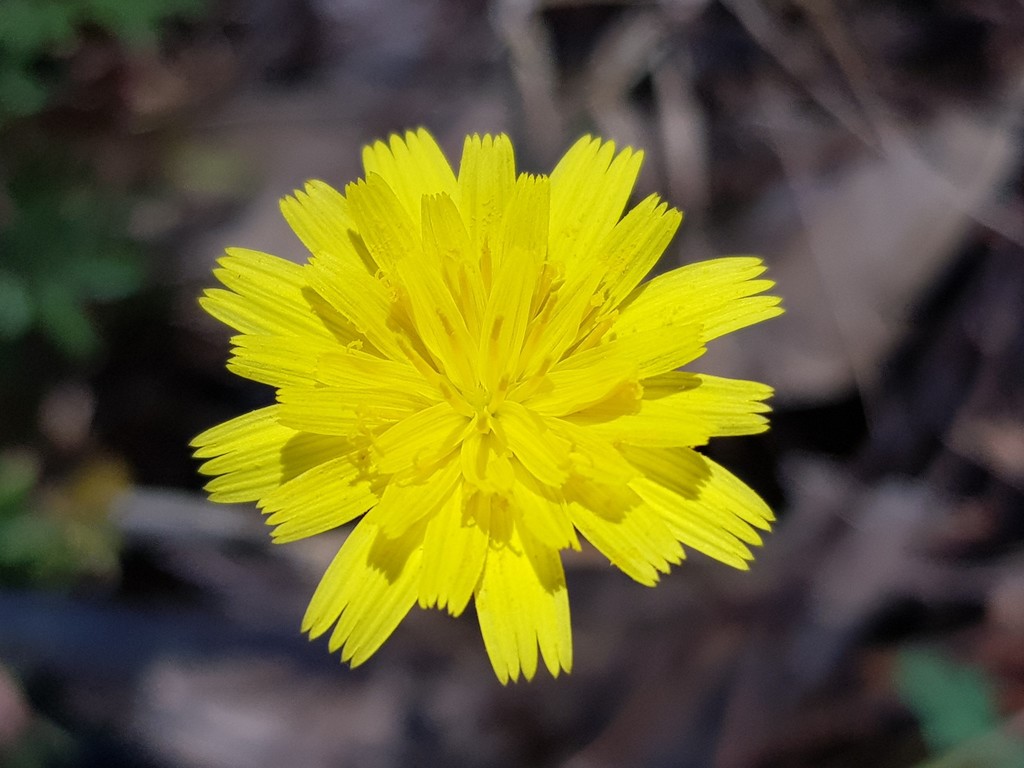
Catsear
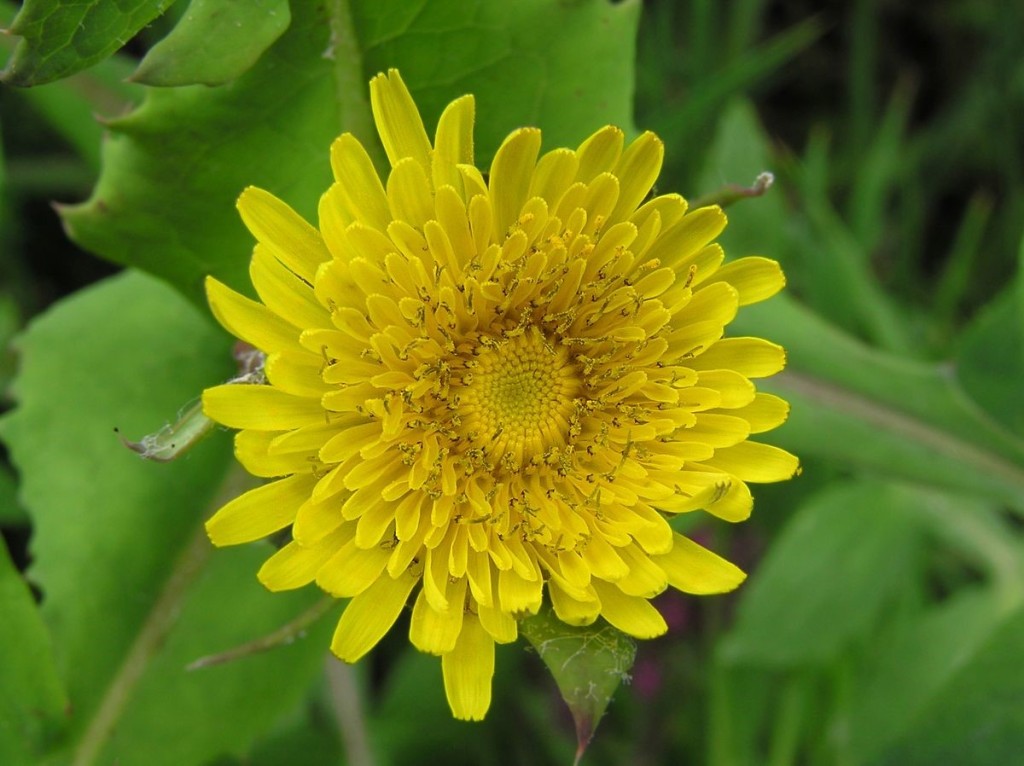
Sowthistle 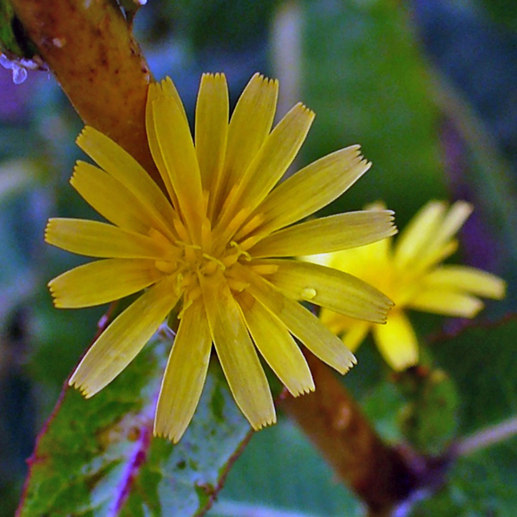
Wild Lettuce
Mature Seed Head

Dandelion 
Catsear
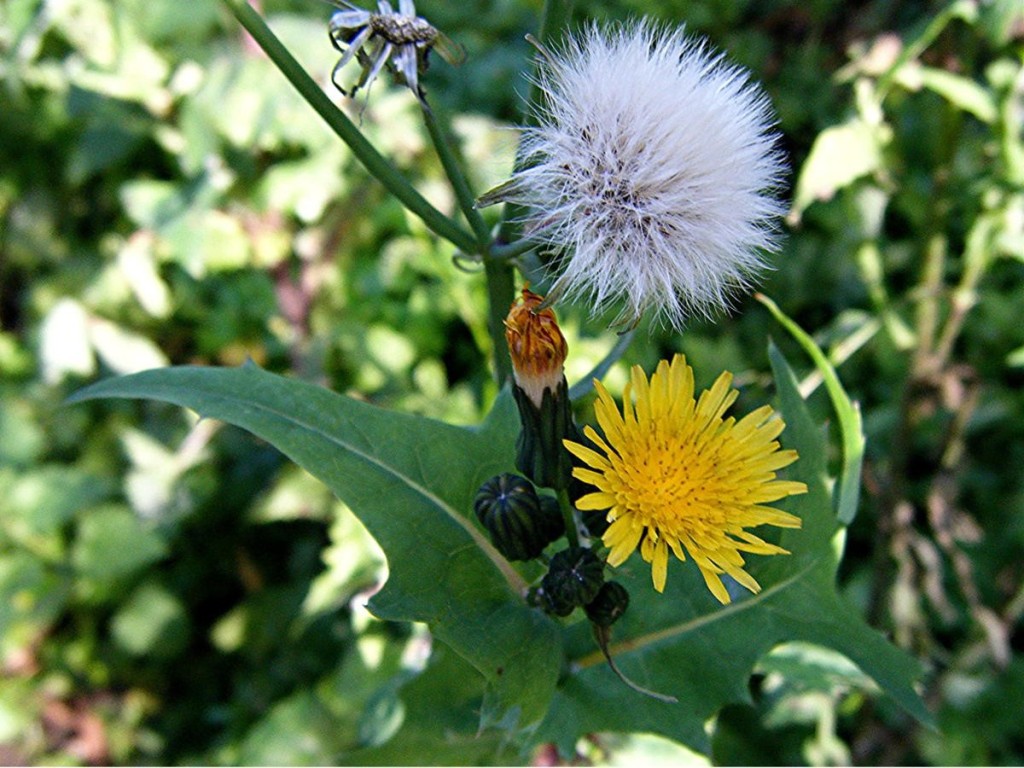
Sowthistle 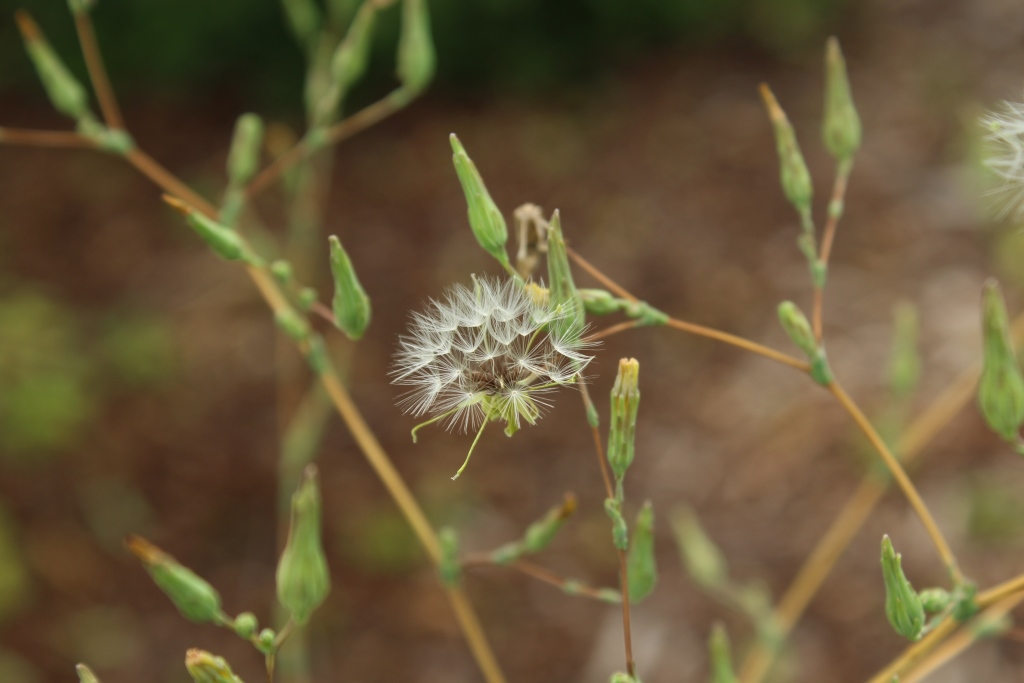
Wild Lettuce
Root
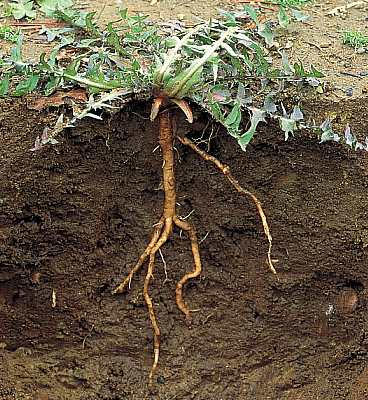
Dandelion 
Catsear
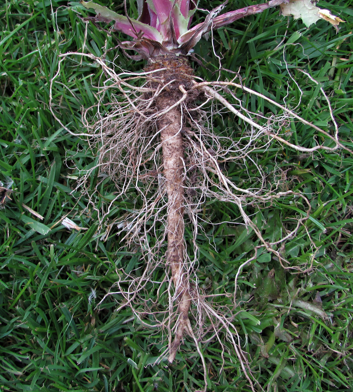
Sowthistle 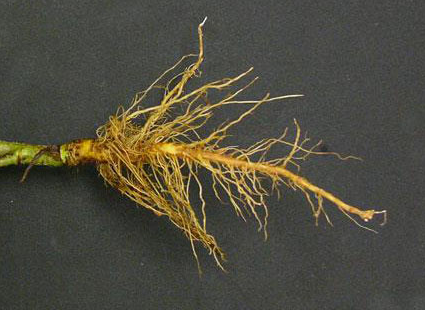
Wild Lettuce
Each species described in this guide have taproots beneficial for survival in poor soils or low water environments. The roots of catsear, sowthistle, wild lettuce and dandelion are all noted as edible when young. Dandelion root is probably the most useful as its edibility extends further into its life-cycle than the others and it is still a commonly used and valuable medicinal herb.
The medicinal qualities of dandelion are relatively well known. Research into the other three plants has shown them all to have historical medicinal use and to having been scientifically assayed and studied in modern times for their medicinal utility.
References
- Abu-Izneid, Tareq & Rauf, Abdur & Shah, Syed Uzair Ali & Wadood, Abdul & Abdelhady, Mohamed & Priymenko, Nathalie & Céline, Domange & Mansour, Nashwa & Patel, Seema. (2018). In Vivo Study on Analgesic, Muscle-Relaxant, Sedative Activity of Extracts of Hypochaeris radicata and In Silico Evaluation of Certain Compounds Present in This Species. BioMed Research International. 2018. 10.1155/2018/3868070.
- Allen, William (1 October 2003). “Plant Blindness”. BioScience. American Institute of Biological Sciences. 53 (10): 926. doi:10.1641/0006-3568(2003)053[0926:PB]2.0.CO;2.
- Anilakumar, Kandangath Raghavan, S. N. Harsha, Mallesha and Rakesh Kumar Sharma. “Lettuce: a promising leafy vegetable with functional properties.” (2017).
- Besharat, S., Besharat, M., & Jabbari, A. (2009). Wild lettuce (Lactuca virosa) toxicity. BMJ case reports, 2009, bcr06.2008.0134. https://doi.org/10.1136/bcr.06.2008.0134
- Funke, I. & Siems, W.-E & Schenk, Regina & Melzig, Matthias. (2002). Lactuca virosa L. and Lactucarium: A molecular-pharmacological essay of analgesic potency. Zeitschrift fur Phytotherapie. 23. 40-45.
- Jamuna, S; Paulsamy S, and Karthika V. 2014. “IN VITRO EVALUATION OF CRUDE ROOT EXTRACTS OF THE PLANT SPECIES, HYPOCHAERIS RADICATA L. FOR POTENTIAL ANTIBACTERIAL ACTIVITY AGAINST SOME HUMAN PATHOGENIC BACTERIA”. Kongunadu Research Journal 1 (1), 46-49. https://doi.org/10.26524/krj11.
- Jimoh, Florence.O; Adedapo, Adeolu.A and Afolayan, Anthony.J : Comparison of the Nutritive Value, Antioxidant and Antibacterial Activities of Sonchus asper and Sonchus oleraceus : Department of Botany, University of Fort Hare, South Africa : Rec. Nat. Prod. 5:1 (2011) 29-42
- Maruta,Y; Y. Fukushi, K. Ohkawa, Y. Nakanishi, S. Tahara, and J. Mizutani, “Antimicrobial stress compounds from Hypochoeris radicata,” Phytochemistry, vol. 38, no. 5, pp. 1169–1173, 1995.
- Miller, R.A. The Magical and Ritual Use of Aphrodisiacs. New York: Destiny Books, 1985.
- Puri, Abhijeet. (2018). A REVIEW ON ETHNOMEDICINAL, PHARMACOLOGICAL AND PHYTOCHEMICAL ASPECTS OF SONCHUS OLERACEUS LINN. (ASTERACEAE). International Journal of Pharmacy and Biological Sciences. 8.
- Senguttuvan,J: S. Paulsamy, and K. Karthika, “Phytochemical analysis and evaluation of leaf and root parts of the medicinal herb, Hypochaeris radicata L. for in vitro antioxidant activities,” Asian Pacific Journal of Tropical Biomedicine, vol. 4, pp. S359–S367, 2014.
- Vilela,Fabiana C; Andressa D. Bitencourt, Layla D.M. Cabral, Lidiane S. Franqui, Roseli Soncini, Alexandre Giusti-Paiva, Anti-inflammatory and antipyretic effects of Sonchus oleraceus in rats, Journal of Ethnopharmacology, Volume 127, Issue 3, 2010, Pages 737-741,ISSN 0378-8741
- Vilela, Fabiana Cardoso; Marina de Mesquita Padilha, Lucas dos Santos-e-Silva, Geraldo Alves-da-Silva, Alexandre Giusti-Paiva, Evaluation of the antinociceptive activity of extracts of Sonchus oleraceus L. in mice, Journal of Ethnopharmacology, Volume 124, Issue 2, 2009, Pages 306-310, ISSN 0378-8741
- Wilson,David A.; Saunders,W.B.:False Dandelion/Flat Weed Toxicosis, 2012, ISBN 9781416099796
- Xu, Y. & Liang, J.-Y. (2005). Chemical constituents of Sonchus oleraceus L. Journal of China Pharmaceutical University. 36. 411-413.
- Zargari, A “Medicinal Plants (in Persian),” Tehran University Press, Tehran, 1990.

